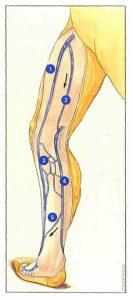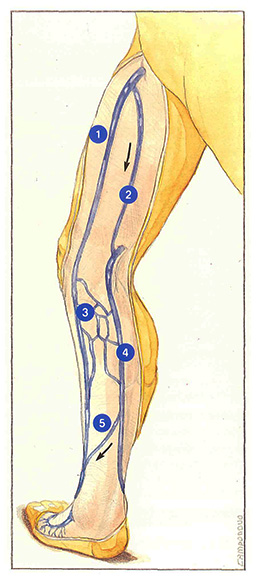Intersaphenous communications
Intersaphenous anastomoses can connect the short and long saphenous networks in the thigh or the leg.
In the thigh, this communication is sometimes ensured by a Giacomini vein (Figure 70-2) or by an anterior tributary in the thigh which reaches the posterolateral border of the popliteal fossa.
The two saphenous networks are very close at the knee and sometimes communicate at this level via a supra- or subaponeurotic vein.
The bulge of the medial head of the gastrocnemius muscle separates the two saphenous systems in the leg, but they may nevertheless communicate via the calf plexus (Figure 70-3) or via direct communicating veins (Figure 70-5) forming veritable saphenous arches.
From a functional point of view, these anatomical arrangements can transmit reflux of the saphenofemoral junction to the short saphenous trunk via a Giacomini vein. The short saphenous trunk can become secondarily incompetent as a result of this overload. Inversely, reflux of the short saphenous network can induce overload of the veins of the long saphenous network.

Further reading
Almgren B., Bowald D., Erikson I. The posterior approach for subfascial ligation of perforating veins. Act Chir Scand 1982; 148: 243-5.
Le Dentu. Recherches anatomiques et considérations physiologiques sur la circulation veineuse du pied et de la jambe. Thèse Paris 1867.
